Periodicity, Stability, and Boundedness of Solutions to Certain Second Order Delay Differential Equations
Abstract
The behaviour of solutions to certain second order nonlinear delay differential equations with variable deviating arguments is discussed. The main procedure lies in the properties of a complete Lyapunov functional which is used to obtain suitable criteria to guarantee existence of unique solutions that are periodic, uniformly asymptotically stable, and uniformly ultimately bounded. Obtained results are new and also complement related ones that have appeared in the literature. Moreover, examples are given to illustrate the feasibility and correctness of the main results.
1. Introduction
It is well known that the existence of boundedness, stability, and periodic solutions are among the most attractive topics in the qualitative behaviour of solutions to ordinary and functional differential equations. There are many articles dedicated so far to the qualitative properties of solutions of second order differential equations. Various authors have discussed these properties of solutions under numerous assumptions through different approaches. Some of these contributions include but are not limited to the works of Burton [1–3], Hale [4], and Yoshizawa [5–7] which contain general results on the subject matter and the expository papers of Ademola [8], Alaba and Ogundare [9], Cahlon and Schmidt [10], Domoshnitsky [11], Grigoryan [12], Jin and Zengrong [13], Kroopnick [14], Ogundare and Afuwape [15], Ogundare and Okecha [16], Tunç [17–21], Wang and Zhu [22], Xianfeng and Wei [23], and Yeniçerioğlu [24, 25] and the rich references cited therein.
The obtained results in the present paper are completely new and they extend previously known results in [8, 9] on second order ordinary differential equations and the works in [23–25] where the deviating arguments are constants. Some mathematical tools that will be needed in the sequel are discussed in Section 2. The main results of this paper are presented in Section 3 while examples are given in the last section to validate our results.
2. Preliminary Results
Definition 1 (see [3].)A continuous function with W(0) = 0, W(s) > 0 if s ≠ 0, and W strictly increasing is a wedge. (We denote wedges by W or Wi, where i is an integer.)
Definition 2 (see [3].)The zero solution of (8) is asymptotically stable if it is stable and if for each t0 ≥ 0 there is an η > 0 such that ‖ϕ‖ ≤ η implies that
Definition 3 (see [2].)An element ψ ∈ CH is in the ω-limit set of ϕ, say Ω(ϕ), if X(t, 0, ϕ) is defined on and there is a sequence {tn}, tn → ∞ as n → +∞, with as n → ∞, where for −r ≤ θ < 0.
Definition 4 (see [26].)A set Q ⊂ CH is an invariant set if for any ϕ ∈ Q, the solution X(t, 0, ϕ) of the system (8) is defined on , and Xt(ϕ) ∈ Q for .
Lemma 5 (see [7].)Suppose that and F(t, ϕ) is periodic in t of period ω, ω ≥ r, and consequently for any α > 0 there exists an L(α) > 0 such that ϕ ∈ Cα implies |F(t, ϕ)| ≤ L(α). Suppose that a continuous Lyapunov functional V(t, ϕ) exists, defined on , ϕ ∈ S∗, S∗ is the set of ϕ ∈ C such that |ϕ(0)| ≥ H (H may be large), and V(t, ϕ) satisfies the following conditions:
- (i)
a(|ϕ(0)|) ≤ V(t, ϕ) ≤ b(‖ϕ‖), where a(r) and b(r) are continuous, increasing, and positive for r ≥ H and a(r) → ∞ as r → ∞;
- (ii)
, where c(r) is continuous and positive for r ≥ H.
Lemma 6 (see [7].)Suppose that F(t, ϕ) is defined and continuous on 0 ≤ t ≤ c, ϕ ∈ CH and that there exists a continuous Lyapunov functional V(t, ϕ, φ) defined on 0 ≤ t ≤ c, ϕ, φ ∈ CH which satisfy the following conditions:
- (i)
V(t, ϕ, φ) = 0 if ϕ = φ;
- (ii)
V(t, ϕ, φ) > 0 if ϕ ≠ φ;
- (iii)
for the associated system
(11) -
one has , where for ‖ϕ‖ = H or ‖φ‖ = H, one understands that the condition is satisfied in the case V′ can be defined.
Lemma 7 (see [7].)Suppose that a continuous Lyapunov functional V(t, ϕ) exists, defined on , ‖ϕ‖ < H, 0 < H1 < H which satisfies the following conditions:
- (i)
a(‖ϕ‖) ≤ V(t, ϕ) ≤ b(‖ϕ‖), where a(r) and b(r) are continuous, increasing, and positive;
- (ii)
, where c(r) is continuous and positive for r ≥ 0.
3. Main Results
Theorem 9. In addition to the assumptions on the functions f, g, p, and ϕ, suppose that a, b, ϕ0, B, α, β, L, M are positive constants and that for all t ≥ 0
- (i)
a ≤ f(·)/y for all x and y ≠ 0;
- (ii)
b ≤ g(x)/x ≤ B for all x ≠ 0;
- (iii)
|g′(x)| ≤ L for all x;
- (iv)
1 < ϕ0 ≤ ϕ(t) for all t ≥ 0;
- (v)
0 ≤ τ(t) ≤ α, τ′(t) ≤ β, 0 < β < 1, where
(14) - (vi)
|p(t, x, y)| ≤ M, 0 < M < ∞.
Remark 10. Below are some observations from previous results which the current results are addressing:
- (i)
When , g(x(t − τ(t))) = bx and p(t, x, y) = 0, then system (7) reduces to linear constant coefficients differential equation , and conditions (i) to (vi) of Theorem 9 specialize to the corresponding Routh Hurwitz criteria a > 0 and b > 0.
- (ii)
When ϕ(t)f(·) = cx′, g(x(t − τ(t))) = g(t, x), and p(t, x, y) = h(t), system (7) specializes to ordinary differential equation discussed in [22]. Our result includes and extends the results in [22].
- (iii)
If τ(t) = τ (a constant), ϕ(t)f(·) = p1y′(t) + p2y′(t − τ), and g(x(t − τ(t))) = q1y(t) + q2y(t − τ), system (7) is trimmed down to that discussed in [10, 24]. Thus our results improve the results in [10, 24].
- (iv)
If τ(t) = 0, ϕ(t)f(·) = c(t, x, x′), g(x(t − τ(t))) = q(t)b(x), and p(t, x, y) = f(t) then system (7) reduces to that considered in [17]. Thus the result in [17] is a special case of Theorem 9.
- (v)
Whenever τ(t) = 0, (6) reduces to the cases discussed in [8, 9].
Lemma 11. Under the hypotheses of Theorem 9, there exist positive constants D0 = D0(b, 1), D1 = D1(a, b, B), and D2 = D2(λ1, λ2) such that
Furthermore, there exist positive constants D3 = D3(a, b, ϕ0, α, β, L, 1) and D4 = D4(a, b, 1) such that
Proof. Let (xt, yt) be any solution of system (7). It is clear from (13) that V(0,0) = 0. Since the double integrals terms are nonnegative, g(x) ≥ bx for all x ≠ 0, and (ax + y) 2 ≥ 0 for all x and y, then there exists a positive constant δ0 such that
t ≥ 0, x and y, where
Next, let (xt, yt) be any solution of the system (7). The time derivative of the function V, defined in (13), along a solution path of the system (7) is
Next, we will give the proof of Theorem 9.
Proof of Theorem 9. Let (xt, yt) be any solution of system (7), hypothesis (vi) of Theorem 9, and the fact that |x | < 1 + x2, and then there exist positive constants δ5 and δ6 such that inequality (31) yields
Theorem 12. Suppose that hypotheses (i) to (v) of Theorem 9 hold; then the zero solution of system (35) is uniformly asymptotically stable.
Remark 13. (i) The stability results in [2, 8–10] are special cases of Theorem 12.
(ii) When ϕ(t)f(·) = p(t)ϕ′(t) and g(x(t − τ(t))) = q(t)ϕ(t) (34) reduces to the one discussed in [12].
(iii) Whenever ϕ(t)f(·) = cx′ and g(x(t − τ(t))) = g(t, x) then (34) is a case studied in [22].
(iv) If ϕ(t)f(·) = 0 and g(x(t − τ(t))) = ax(t) then (34) reduces to the one discussed in [25].
Proof of Theorem 12. Let (xt, yt) be any solution of system (35), with hypotheses of Theorem 12; estimates (17), (21), and (22) hold. Furthermore, the derivative of the functional V defined in (13) with respect to the independent variable t along the solution path of the system (35) is
Theorem 14. If hypotheses (i) to (vi) of Theorem 9 hold, then there exists a unique periodic solution of period ω for the system (7).
Proof. Let (xt, yt) be any solution of system (7). In view of the hypotheses of Theorem 14 (19) and inequality (20) hold. Moreover, from hypothesis (vi) and the fact that
4. Examples
In this section, we present examples to check the validity and effectiveness of our results.
Example 1. Consider a second order delay differential equation
-
(i) The function
(43) -
Since
(44) -
for all t ≥ 0, it follows that
(45) -
for all t ≥ 0. The behaviour of ϕ(t) is shown in Figure 1.
-
(ii) The function
(46) -
It is not difficult to show that
(47) -
for all t ≥ 0, x and y ≠ 0. See the behaviour of f(·) in Figure 2.
-
(iii) The function
(48) -
Since
(49) -
for all x, then we assert that
(50) -
(iv) The function
(51) -
Clearly, g′(x) is a bounded function; thus it is not difficult to show that
(52) -
The boundedness of g and g′ is shown in Figure 3.
-
(v) The function
(53) -
Since
(54) -
for all t ≥ 0, x and y, it follows that
(55) -
for all t ≥ 0, x and y; and if
-
(vi) β = 1/2, and with the values of a, b, B, L, M as above, then inequality (14) becomes
(56)
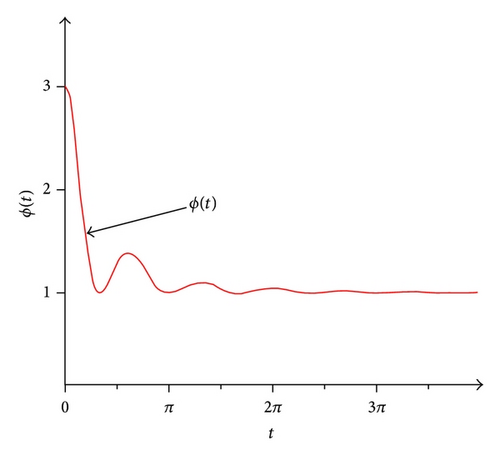
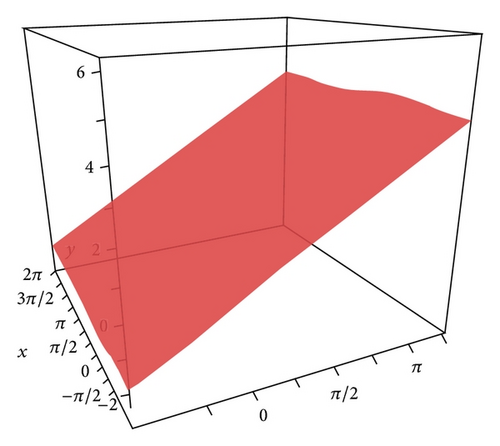
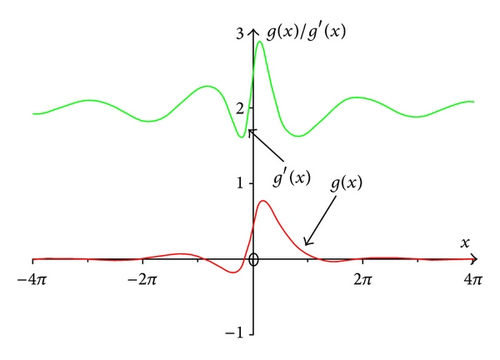
Example 2. Consider the second order delay differential equation
Equation (57) is equivalent to system of first order differential equation
- (i)
The function
(61) -
Noting that
(62) -
for all t ≥ 0, x and y, we assert that
(63) -
for all t ≥ 0, x and y ≠ 0. The function f(·) is shown in Figure 4.
- (ii)
The function
(64) -
Let
(65) -
Since
(66) -
for all x, it follows that
(67) -
for all x ≠ 0.
- (iii)
Furthermore, from (ii) above we have
(68) -
It is not difficult to show that
(69) -
for all x. The functions g(x)/x, G(x), and |g′(x)| are shown in Figure 5.
- (iv)
The function
(70) -
Since
(71) -
for t ∈ [0,2π], it follows that
(72) -
for all t ≥ 0. The graph of function ϕ(t) is shown in Figure 6.
- (v)
Moreover, choose β0 = 1/2 and from (i) to (iv) of Example 2 we have
(73) -
so that
(74) - (vi)
The function
(75) -
Since
(76) -
for all x and y, it follows that
(77) -
for all t ≥ 0, x and y.
- (i)
solutions of system (59) are uniformly bounded and uniformly ultimately bounded;
- (ii)
there exists a unique periodic solution of period ω,
- (iii)
the trivial solution of the system (59) (when p(t, x, y) = 0) is uniformly asymptotically stable.
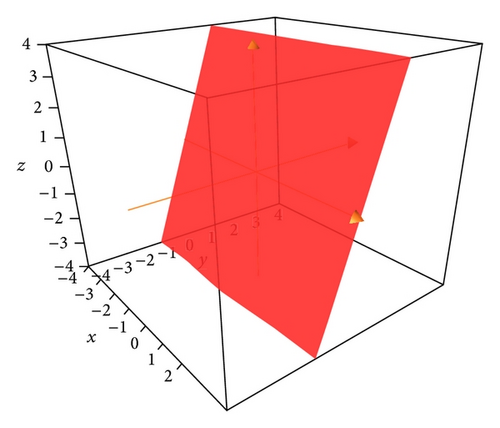

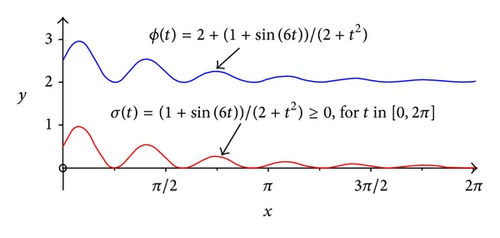
Competing Interests
The authors declare that they have no competing interests.




